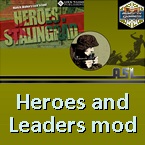asl3d
Posts: 6531
Joined: 2/6/2017
Status: offline

|
Panzergrenadier is a German term for motorised or mechanized infantry – that is, infantry transported in combat vehicles specialized for such tasks – as introduced during World War II.
The term Panzergrenadier was not adopted until 1942. Infantry in panzer divisions from 1937 onwards were known as Schützen Regiments; they wore the same rose pink piping on their uniforms as the tank crews (with an "S" cypher that distinguished the Schützen from the tank and anti-tank units that also wore that colour). Soldiers in special Motorized Infantry units wore the standard white piping of the Infantry. In 1942, when Infantry Regiments were renamed as Grenadier Regiments by Hitler as a historical homage to Frederick the Great's Army, the Schützen regiments (and the soldiers in them) began to be redesigned as Panzergrenadier regiments, as did Motorized Infantry units and soldiers. Their Waffenfarbe was also changed from either white (in the case of Motorized Infantry) or rose pink to a meadow-green shade previously worn by motorcycle troops. Some units did not change over their designations and/or Waffenfarbe accoutrements until 1943, and many veteran Schützen ignored regulations and kept their rose-pink until the end of the war.
The term Panzergrenadier had been introduced in 1942, and was applied equally to the infantry component of Panzer divisions as well as the new divisions known as Panzergrenadier Divisions. Most of the Heer's PzGren. divisions evolved via upgrades from ordinary infantry divisions, first to Motorized Infantry divisions and then to PzGren. divisions, retaining their numerical designation within the series for infantry divisions throughout the process. This included the 3rd, 10th, 14th, 15th, 16th, 18th, 20th, 25th, and 29th divisions. Others, such as the Großdeutschland Division, were built up over the course of the war by repeatedly augmenting the size of an elite regiment or battalion. The Waffen-SS also created several PzGren. divisions by the same methods, or by creating new divisions from scratch later in the war. A number of PzGren. divisions in both the Heer and Waffen-SS were upgraded to Panzer divisions as the war progressed.
The Panzergrenadier divisions were organized as combined arms formations, usually with six battalions of truck-mounted infantry organized into either two or three regiments, a battalion of tanks, and an ordinary division's complement of artillery, reconnaissance units, combat engineers, anti-tank and anti-aircraft artillery, and so forth. All these support elements would also be mechanized in a PzGren. division, though most of the artillery, anti-tank, and anti-aircraft elements were equipped with weapons towed by trucks rather than the relatively rare armoured and self-propelled models. In practice the PzGren. divisions were often equipped with heavy assault guns rather than tanks, due to a chronic shortage of tanks throughout the German armed forces. A few elite units, on the other hand, might have the tanks plus a battalion of heavy assault guns for their anti-tank element, and armoured carriers for some of their infantry battalions as well.
On paper a Panzergrenadier division had one tank battalion less than a Panzer division, but two more infantry battalions, and thus was almost as strong as a Panzer division, especially on the defensive. Of 226 panzergrenadier battalions in the whole of the German Army, Luftwaffe and Waffen SS in September 1943, only 26 were equipped with armoured half tracks, or just over 11 percent. The rest were equipped with trucks.
The use of armoured half-tracks was rare in the German Army, and even the elite Großdeutschland Division, with two panzergrenadier regiments, only mustered a few companies' worth of the vehicles, generally SdKfz 251 troop carriers. The vast majority of Schützen/Panzergrenadier soldiers were mounted in trucks. Additionally, vehicles in the early war period suffered from poor off-road performance.
In 1944 a couple of Panzer Divisions based in France had more than the standard one battalion mounted in SdKfz 251 troop carriers. The Panzer Lehr Division's infantry and engineers were entirely mounted in SdKfz 251 troop carriers, while the 1st Battalion in both Panzergrenadier regiments in 2. Panzer Division and 21. Panzer Division were half-equipped with armoured halftracks (SdKfz 251 troop carriers for 2. Panzer, U304(f) light armoured personnel carriers for 21. Panzer).

 Attachment (1) Attachment (1)
_____________________________
Semper fidelis
|
 Printable Version
Printable Version





































 New Messages
New Messages No New Messages
No New Messages Hot Topic w/ New Messages
Hot Topic w/ New Messages Hot Topic w/o New Messages
Hot Topic w/o New Messages Locked w/ New Messages
Locked w/ New Messages Locked w/o New Messages
Locked w/o New Messages Post New Thread
Post New Thread